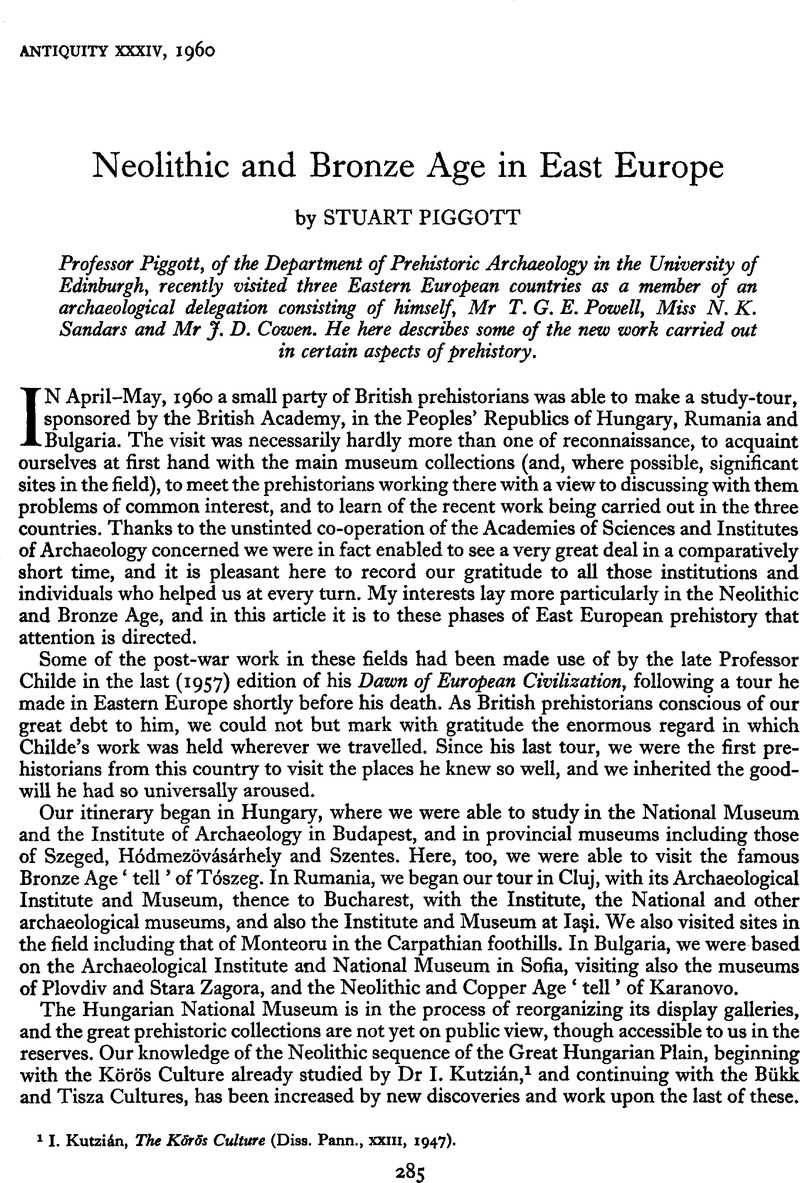No CrossRef data available.
Published online by Cambridge University Press: 02 January 2015

1 I. Kutzián, The Körös Culture (Diss. Pann., XXIII, 1947).
2 O. Trogmayer, Evkönyve a Mora Ferenc Mus. Szeged, 1957, 19.
3 J. Banner in Germania, XXXVII (1959), 14 (pots); ibid., A Kökénydomb neolithikori telep (1931), pl. n; Hódmezövdsarhely története a honfoglalds koráig (1940), pl. XLVI; Prähist. Zeitsch XXI (1930), 184.
4 Acta Arch. Hung., XI (1959), 7.
5 J. Dombay, ‘Die Siedlung un das Gräberfeld in Zengövárkony’ (Arch. Hung., N.S. XXXVII, 1960).
6 Cf. Bericht R-G Komm., XXXIII (1943-50), 61, 81.
7 H. H. Coghlan, Journ. Royal Anthrop. Inst., LXXIII (1943), 52; ibid., Notes on Prehist. Metallurgy of Copper and Bronze . . . (1951), 56; Childe, Univ. Lond. Inst. Arch. Ann. Reports, VII (1951), 44.
8 J. Banner, ‘Die Péceler Kultur’ (Arch. Hung., N.S. XXXV, 1956). Note too the recent studies of P. Patay in Arch. Ertesitö, xxxv (1958), 37; Acta Arch. Hung., IX (1958), 141; Slovenská Arch. VI-2 (1958), 301.
9 Childe, Dawn (1957), 124; cart model also in Thomas, Arch. Funde aus Ungarn (1957), 78.
10 Dr Kutzián has recently looked to the south for influences on Hungarian Copper Age pottery (Acta Arch. Hung., IX (1958), 155). Cf. Childe’s comments in ibid., VII (1956), 1. For distribution-maps of copper axes, axe-adzes and other types in East Europe, cf. Driehaus in Arch. Geog., II (1952-55), 1.
11 Cf. Acta Arch. Hung., II (1952), 54 for a preliminary sketch of this scheme.
12 A. Moszolics, ‘Die Friihbronzezeitliche Urnenfriedhof von Kisaopostag’ (Arch. Hung., XXVI, 1942).
13 Cf. Vogt in Tschumi-Festschrift (1948), 53; Hundt, Katalog Straubing I, (i958)-
14 As for instance in R. Hachmann, Friihe Bronzezeit im West. Ostseegebiet (1957), Taf. 70.
15 Arch. Ertesito, LXXXVI (1959), 49.
16 Studied by Dr Moszolics for Hungary III Acta Arch. Hung., in (1953), 69, and by Dr Jelínková for Bohemia and Moravia in Acta Univ. Carolinae (Phil, et Hist., 3), Filip-Festschrift, 1959), 183.
17 Acta Arch. Hung., VIII (1957), 119.
18 E.g. that of Bóna in Acta Arch. Hung., IX (1958), an.
19 Dacia, N.S. II (1958), 35; Slovenská Arch., VI-2 (1958), 257.
20 D. Berciu, Une civilisation néolithique . . . la civilisation de Hamangia (195s).
21 As in C. Zervos, L’Art des Cyclades (1957), nos. 53-58.
22 Ibid., nos. 316-7.
23 R. Vulpe, Izvoare: săpăturile din 1936-1948 (1957).
24 V. Dumitrescu et al., Hăbăşeşti: monografie arhéologica (1954).
25 Dacia, IX-X (1941-44), II.
26 Analele Spiinfifice Univ. laşi, Sect. II, III (1957), fasc. 1-2; Materiale si cercetari arhéologice, VI (1959), 147.
27 Ibid., 789.
28 Ibid., 213.
29 Arch. Rozh., x (1958), 62; for the two types, cf. M. Gimbutas Prehist. East Europe, 1 (1956), 163, fig. 98.
30 D. Popescu, Die Frühe und Mittlere Bronzezeit in Siebenburgen (1944).
31 I. Nestor, Sur les débuts de la metallurgie du cuivre et du bronze en Roumanie (1955).
32 Preliminary reports in Materiale, III (1957), 189 ; V (1959), 265. For the figurines, IPEK, 19, (1954-9), 16ff.
33 E. Dunareanu-Vulpe, in Studii asupra tezaurului restituit de U.R.S.S. (1958). The famous Pietroasa treasure of the 4th century A.D. is also among the objects now returned to Rumania.
34 Professor Mikov communicated an account of his excavations to the International Congress of Pre- and Protohistoric Sciences at Hamburg in 1958; summary in Archeeology, XIII (1959), 88.
35 ANTIQUITY, XIII (1939), 345 and pl. III.
36 Ann. Mus. Nat. Arch. Plovdiv, III (1959), 3.
37 J. H. Gaul, ‘The Neolithic Period in Bulgaria’ (Amer. School Prehist. Research Bulletin, XVI, 1948), 79.
38 Dawn (1957), 103.
39 Cf. Clark’s comments in Prehist. Europe: The Econ. Basis (1952), 131.
40 Cf. Garašanin’s map in Bericht R-G Komm., XXXIII (1943-50), 127.
41 Op. cit., Ch. VII.
42 Dawn (1957), 127.
43 One objection to Mr Mellaart’s high chronology is that if Baden is dated to c. 3000 B.C. rather than to c. 2000 B.C., an enormous gap is left in the Hungarian sequence between this phase (Copper Age III) and that of Bronze Age III, -which with its Late Helladic contacts can hardly be before the 15th century B.C. A millennium-and-a-half for Nagyrév and Hatvan does seem excessive !
44 Dacia, II (1925), 345.
45 Ibid., V-VI (1935-36), 169.
46 Man, 1923, no. 107.